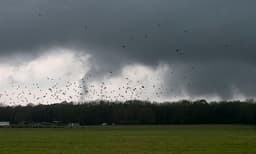Home / Science / Powerful Solar Storm Disrupts Power Grids and Satellites Across North America
Powerful Solar Storm Disrupts Power Grids and Satellites Across North America
10 Nov
Summary
- Powerful G3 geomagnetic storm striking Earth, disrupting power grids and satellites
- Storm expected to linger through Thursday, with potential for auroras in northern US
- Scientists warn of growing 'weak spot' in Earth's magnetic field increasing solar risks

A major solar storm is currently striking Earth, disrupting the planet's magnetic field and putting power grids, satellites, and GPS systems across the northern United States at risk. The G3-level geomagnetic storm, considered 'strong,' began late Wednesday night and is expected to linger throughout Thursday.
The storm's effects peaked between 1:27 AM and 2 AM ET on Thursday morning, but the National Oceanic and Atmospheric Administration (NOAA) notes the solar event is still at G2 strength heading into the afternoon. This storm is the result of multiple solar eruptions, including flares and coronal mass ejections, that have been detected since November 3rd.




